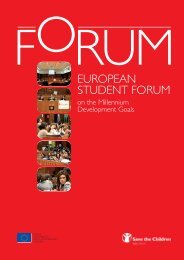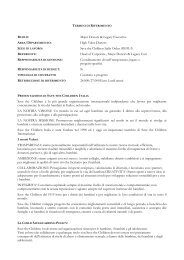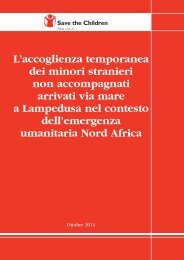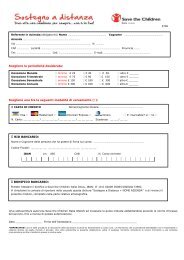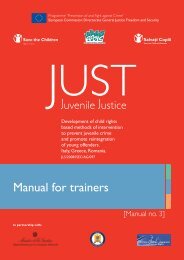FINAL REPORT - Save the Children Italia Onlus
FINAL REPORT - Save the Children Italia Onlus
FINAL REPORT - Save the Children Italia Onlus
You also want an ePaper? Increase the reach of your titles
YUMPU automatically turns print PDFs into web optimized ePapers that Google loves.
9. Conclusion and recommendationsAcknowledging that child trafficking is a very complex phenomenon and that it isprimarily a human rights issue, and recognising that identification and support ofchild victims and children at risk of trafficking is crucial to ensure <strong>the</strong>ir protection, achild rights based, multi-disciplinary and inter-agency approach has informed <strong>the</strong>development of <strong>the</strong> methodology to identified and support chid victims of trafficking inthis AGIS project. This methodology, (<strong>the</strong> AGIS methodology) presented in Part III ofthis Report, is intended to be a tool that should guide relevant stakeholders in <strong>the</strong>development of national instruments, such as protocols and operating procedures forchildren’s identification and support. The project partners conclude that <strong>the</strong>se nationalinstruments should reflect <strong>the</strong> specificity of <strong>the</strong> national context where <strong>the</strong>y areimplemented and that <strong>the</strong>y should be constantly reviewed to respond to <strong>the</strong> changingnature of child trafficking. They are also of <strong>the</strong> opinion that national protocols andoperating procedures should be sufficiently detailed to foster comprehensiveidentification of trafficked children and believe that <strong>the</strong> methodology developed in thisproject, although complex and elaborated, could guarantee this specificity and detail.Below are presented <strong>the</strong> recommendations resulting from <strong>the</strong> experience gained within <strong>the</strong>AGIS project: “Development of a child rights methodology to identify and support childvictims of trafficking”. They are specifically focused on identification and support of childvictims of trafficking.<strong>Save</strong> <strong>the</strong> <strong>Children</strong> Italy, acting as project coordinator, shared part of <strong>the</strong>se recommendationswith <strong>the</strong> <strong>Save</strong> <strong>the</strong> <strong>Children</strong> Europe Group in June 2007, who reflected <strong>the</strong>m into<strong>the</strong>ir written submissions 42 presented on <strong>the</strong> occasion of <strong>the</strong> EU anti-trafficking day(Brussels, 18 October 2007).General recommendations1. A multi-disciplinary and inter-agency approach should guide <strong>the</strong> development ofidentification and support measures at European as well as national and local level.2. A child rights based approach should be used in <strong>the</strong> development of specific tools(such as Protocols and operating procedures) to identify and support child victims oftrafficking, ensuring that human rights concerns are given primary importance in <strong>the</strong>design of such measures, in accordance with international obligations deriving frominternational human rights standards, such as <strong>the</strong> CRC. In particular, <strong>the</strong> generalprinciples of <strong>the</strong> CRC, namely, <strong>the</strong> best interests of <strong>the</strong> child, <strong>the</strong> right toparticipation, <strong>the</strong> right to non-discrimination and <strong>the</strong> right to life, survival anddevelopment should always be respected and implemented.6. Assistance should always be provided to child victims or presumed victims,independently of <strong>the</strong>ir willingness to cooperate with <strong>the</strong> authorities.7. In designing support measures for child victims, special attention shall be given to<strong>the</strong> children’s needs arising from <strong>the</strong>ir previous condition of deprivation and <strong>the</strong>impact of violence, trauma and loss <strong>the</strong>y may have suffered.Recommendation to EU Institutions8. Mandatory provisions regarding identification and support of child victims,including <strong>the</strong> principles detailed above in previous recommendations, should beadopted at European Union level and should reflect existing best practices in EUMember States. They should also build upon <strong>the</strong> experience of EU projects,specifically focused on identification and support of child victims.Recommendations to EU Member States9. The project partners recommend <strong>the</strong> use of <strong>the</strong> child rights based methodology ofidentification and support of child victims of trafficking developed in this project,<strong>the</strong> AGIS methodology, in <strong>the</strong> development of specific national and transnationaltools (e.g. protocols) to identify and support child victims and children at risk oftrafficking.10. Specific and detailed profiles of children most at risk of trafficking and child victimsshould be developed and constantly reviewed at national level, in <strong>the</strong> light of up-todateresearch findings on child trafficking and with <strong>the</strong> involvement of all relevantstakeholders.11. Specific indicators to identify child victims and children at risk of trafficking shouldbe developed and periodically updated at national level and with <strong>the</strong> involvement ofall relevant stakeholders.12. Clear operating procedures should be adopted at national level with <strong>the</strong> involvementof all relevant stakeholders, indicating <strong>the</strong> specific mandates and methods ofcooperation between all actors involved in <strong>the</strong> identification process of child victimsand children at risk.3. All actors involved in <strong>the</strong> identification and support process of child victims shallreceive special training.42<strong>Save</strong> <strong>the</strong> <strong>Children</strong>Submissions on KeyComponents of <strong>the</strong> EURecommendations toEnhance NationalCoordinatingMechanisms for EarlyIdentification,Assistance andProtection of <strong>the</strong> Rightsof Victims ofTrafficking, 27 June2007.4. Age assessment should always be conducted in light of <strong>the</strong> best interest of <strong>the</strong> childand by independent professionals with appropriate expertise. It should be part of abroader, holistic needs assessment of <strong>the</strong> child and physical, psychological andcultural factors should be taken into account. Fur<strong>the</strong>rmore, age assessmentprocedures should not be harmful. <strong>Children</strong> should be consulted prior to any ageassessment procedures and <strong>the</strong>ir participation should be voluntary. In case of doubt<strong>the</strong>re should be a presumption that someone claiming to be less than 18 years of age,will provisionally be treated as such. In making a final age determination, childrenshould be given <strong>the</strong> benefit of <strong>the</strong> doubt.5. Child friendly interviewing techniques of child victims and children at risk should bedeveloped and implemented during interviews.7879



